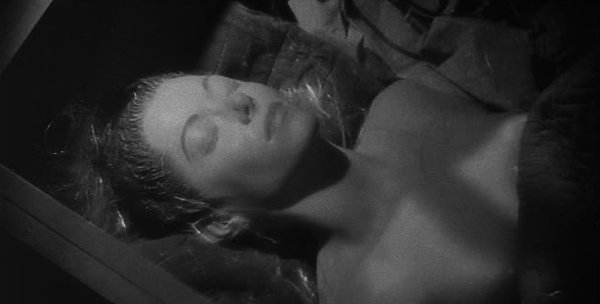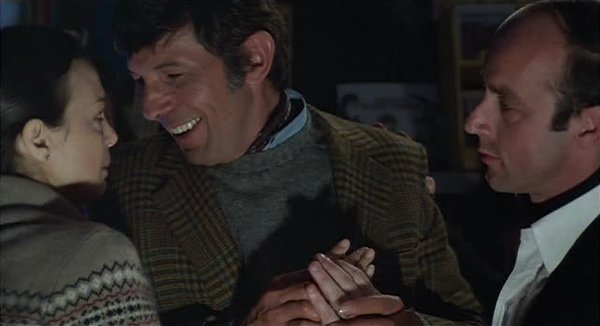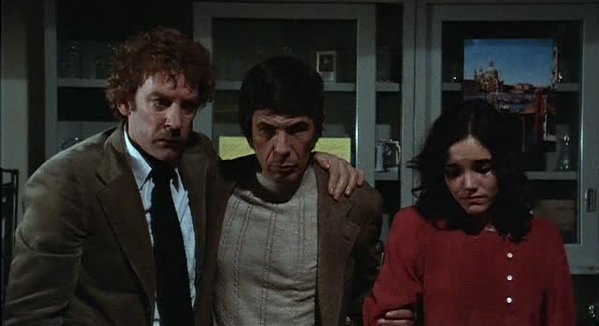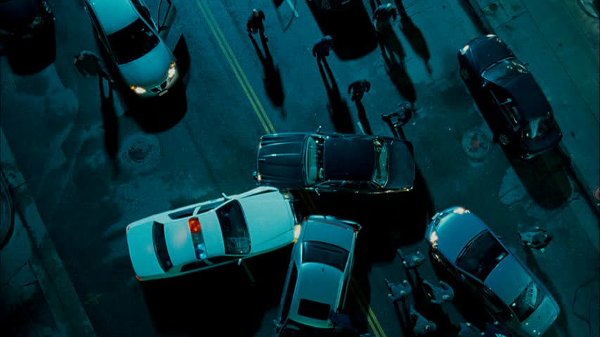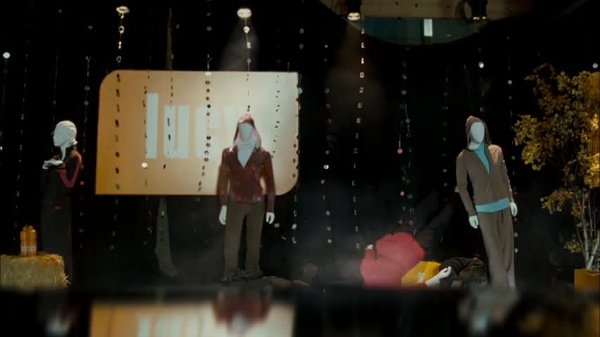Spoiler Scale (How spoilery is this article on a scale of 1 to 10?): 6
In the 60 years since Collier’s magazine first published Jack Finney’s serial, The Body Snatchers, there have been four film adaptations, as the pod people narrative seems to have a “Shakespearean mobility from one period to the next” (Mike Davis, author of The Monster at Our Door: The Global Threat of Avian Flu (2005)). In each of the four films, there is at least one sequence where the still-human protagonists must walk down a street filled with pod people, disguising themselves by simply betraying no emotions. Whatever the filmmaker’s spin (or lack thereof) tailored to each period, the basic allegorical destruction that lies behind the horror has always remained the same: the conformist repression of the individual for the sake of society.
In Invasion of the Body Snatchers (1956), directed by Don Siegel from a screenplay by Daniel Mainwaring (which then-actor Sam Peckinpah also claimed partial credit for), Dr. Miles Bennell (Kevin McCarthy, already an Oscar-nominated founding member of The Actor’s Studio) returns from a medical conference to discover that a silent evil has taken over his small town. Newly-divorced former sweetheart Becky Driscoll (Dana Wynter) asks Miles to visit her cousin, who has come to believe that her uncle is an imposter (“there’s something missing … there’s no emotion, none, just the pretense of it”). Miles recommends a local psychiatrist, who dismisses the phenomenon as “an epidemic of mass hysteria.” But later that evening, Miles is called out to the house of his friend, Jack, where a “vague” body (“all the features, but no details … waiting for the final finished face to be stamped onto it”) has just shown up inside his house. But before the morning comes, the body has become a complete likeness of Jack – right down to a cut on the hand. Shortly thereafter, it becomes clear that the seeds of an alien race have drifted to the Earth to replicate and replace us while we sleep.
The original film’s place in history certainly intimates that the pod people represent communism, stripping away all that’s American from small town America (“love, desire, ambition, faith – without them life’s so simple, believe me”), as well as an arguably contradictory reflection upon the red scare. But in so much as we can trust the word of the storytellers themselves, Finney and Siegel denied that there was any direct political intent behind the novel or the film – even after the threat of blacklisting would have subsided. In an interview that accompanies the DVD, McCarthy revealed that at the time he considered the film to be a metaphor for the dehumanizing effects of Madison Avenue. To be sure, the most direct expository dialogue in the film offers little textual support for such a specific agenda:
Miles: “In my practice, I’ve seen how people have allowed their humanity to drain away. Only it happened slowly, instead of all at once. They didn’t seem to mind.”
Becky: “Just some people, Miles.”
Miles: “All of us, a little bit. We harden our hearts, real callous. Only when we have to fight to stay human do we realize how precious it is to us. How dear, as you are to me.”
[Miles and Becky kiss]
Regardless of whether the allegorical content was soft-peddled or simply nonexistent, and in spite of an awkwardly unnecessary voice-over narration by McCarthy, the original Invasion of the Body Snatchers is remarkably effective. In contrast with most of the genre fare of the mid-1950s, Siegel worked well within the limitations of their special effects budget ($15,000) to create a genuine sense of skin-crawling dread, and to his credit, resisted the optimistic epilogue added by the studio (i.e., everything the comes after Miles madly and impotently raving in the middle of the road).
Over a decade later, Siegel would go on to direct one of the most notorious films of the 1970s – Dirty Harry (1971). And coincidentally, whereas actor/director Clint Eastwood co-dedicated Unforgiven (1992) to Siegel, Eastwood also notoriously fired the director of the remake (Invasion of the Body Snatchers (1978)) – Phillip Kaufman – on the set of The Outlaw Josie Wales (1976). As it turns out, however, Kaufman’s unsaturated, shadowed palette proved to be the best-suited milieu for the tale. The strength of the 1978 remake starts with the screenplay by W.D. Richter. While maintaining many of the beats from the original film (including a spot-on cameo by McCarthy), Richter and Kaufman recontextualized the story into a contemporary urban setting (San Francisco) with a distinctly genre-literate flair (e.g., a reference to Star Maker by Olaf Stapledon (1937) trumps Worlds in Collision by Immanuel Velikovsky (1950)).
The opening credits depict feathery spores ascending from a spent planet, traveling with the solar winds through space, finding their way into the Earth’s atmosphere, falling within the drops of rain, sprouting tendrils on the leaves they land upon, emulating the plant-life to become innocuous little pods with flowers to be picked by children in the park. As the film begins, Elizabeth Driscoll (Brooke Adams) arrives home with one of the pods; her husband Jeffrey (Art Hindle) is turned out with his headphones on, intently watching a basketball game on TV, reacting only to the next big play. The next morning, Jeffrey takes a load of garbage directly out to a garbage truck; suddenly he has no interest in sports; there’s some sort of scar on the back of his neck. She follows him the following day, where he meets strange people in strange places. Visibly shaken, Elizabeth eventually confides in her friend/co-worker, Matthew (Donald Sutherland), a public health inspector/foodie who sports a noirish trench coat and shakes down French restaurants (“we don’t have any secrets from the Department of Health”). At Matthew’s behest, they visit his friend and psychiatrist, Dr. David Kibner (Leonard Nimoy), at his own book signing, only to discover him comforting a woman who believes her husband is no longer her husband. Dr. Kibner reunites the couple, professing to have heard the same story from six different patients but attributing the phenomenon to platitudes (“Is it more likely that you want to believe he’s changed before you’re looking for an excuse to get out”).
Echoing the Watergate scandal – still fresh in the minds of the American psyche circa 1978 – Elizabeth refuses to abandon her feelings (“I keep seeing these people, all recognizing each other. Something’s passing between them all – a secret. It’s a conspiracy. I know.”) As it turns out, Elizabeth is right, and the logical, sympathetic, calming, and perfectly-cast Dr. Kibner ultimately reveals himself to be one of the chief facilitators of the invasion.
In Kaufman and Richter’s take, new age psychology/spirituality (e.g., est) – a repackaging of the “oneness” of Zen Buddhism and Taoism and the rejection of the individual as a separate entity – becomes the allegorical villain, the gateway drug to a cult (e.g., Heaven’s Gate). Indeed, Western civilization’s communal anxiety over “new religious movements” – manipulating children away from their nuclear families – would reach a crescendo with the tragic deaths of 918 men, women, and children at Jonestown, Guyana, only a month prior to the release of the film.
Twenty-two years later, the special effects are upgraded, as the physical link and transformation between the human target and the parallel pod person is made a bit more explicit and explicable. That said, this remake ultimately achieves its optimal level of existential unease from jazz musician Denny Zeitlin’s electronic heart-pumping score and Kaufman’s attention to visual and aural detail. Even in the opening scenes, a scream can be heard from a sidewalk ever so faintly; and as the characters walk through a hallway of a state building, anonymous faces peer from behind the windows in the background. And with more fleshed-out characters and convincing performances (particularly from Adams and Sutherland), the 1978 film is not only the most convincing adaptation of this story, but may be one of the best remakes in cinema history.
In contrast, Body Snatchers (1993) is, quite unapologetically, a B-movie – a rather curious entry in director Abel Ferrara’s oeuvre (between the caustic neo-noir, Bad Lieutenant (1992), and the genre/indie amalgamation, The Addiction (1995)). Notwithstanding a relatively impressive cast (including Gabrielle Anwar, fresh off her debut in Scent of a Woman (1992)), aside from a few inspired scenes (e.g., the finger-painting and bathtub sequences), Body Snatchers feels like direct-to-video fare indicative of that period. The talents of R. Lee Emery and Forest Whitaker are largely wasted with irredeemably stilted dialogue. And both the mythology and special effects are derived largely from the 1978 film.
But to its credit, Body Snatchers presents a distinct change in the context of that mythology – and the underlying metaphor – in interesting ways. On the heels of the first Gulf War, the aliens first take hold in that bastion of conformity – a U.S. military base in Alabama. And whereas the chief protagonist is a late-teen girl (Anwar), the chief antagonist/person is her step-mother (Meg Tilly), who is scheming to steal the very identity of her father (Terry Kinney).
In each of the four films, there is at least one pod person who attempts to convince the two human characters not to resist; but in Boby Snatchers, Tilly’s appeal is distinctly chilling, focusing not on comforting the humans but pointing out the inevitability of their consumption. (Ironically, the word “invasion” is missing from the title of the one adaptation where the it would have been most appropriate.)
For the most recent and most distinguishable adaptation, The Invasion (2007), the committee of filmmakers (three screenwriters, Dave Kajganich and the Wachowski brothers, and two directors, Oliver Hirschbiegel and James McTeigue) actually took a cue from a monologue the 1978 film, where the paranoid ex-hippie played by Veronica Cartwright (who also appears here) hypothesizes on the means of an alien invasion: “Why do we always expect metal ships? … I mean, we eat junk, we breathe junk. … They could start getting into our systems and screwing up our genes, like DNA, recombining us and changing us.”
For all of its polished production values and A-list actors (Nicole Kidman, Daniel Craig), The Invasion suffers from a simultaneous lack of subtlety and lack of metaphorical context. Drawing directly from the Columbia disaster, an alien microbe attached to the debris immediately overtakes humanity – not through pods that suck the life out of its human host, but by simply re-sequencing our DNA while we sleep. Mere exposure to the bodily fluid of a pod person and a good night’s sleep is all it takes, and one of the first victims is the director of the CDC (Jeremy Northam), which puts the entire nation at a distinct disadvantage. Add in a lot of unnatural and expository dialogue with the Science Guy (Jeffrey Wright), who tends to drop in (literally) at just the right moment, and this rendering becomes dramatically inert. The obligatory action sequences do not counter the overwhelming sense of inevitability, and only a big fat cheat can get the writers out of the narrative corner they painted themselves into.
Of course, there are overt references to contemporary apprehensions and random social commentary within The Invasion (some even echoing McCarthy’s interpretation in the original film).
But with all the cooks in the kitchen brewing up The Invasion, those references are never cohere. What did those specific fears of global pandemics or spacecraft falling from the sky have to do with the fundamental metaphor of loss of identity? Nada.
Grades:
Invasion of the Body Snatchers (1956): B
Invasion of the Body Snatchers (1978): A
Body Snatchers (1993): C+
The Invasion (2007): C-



